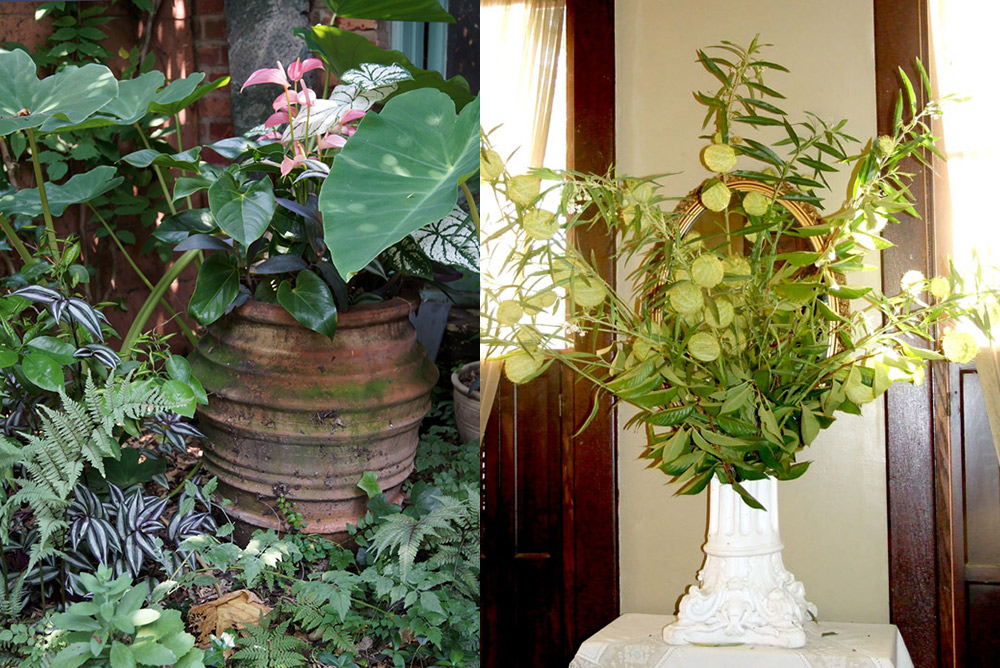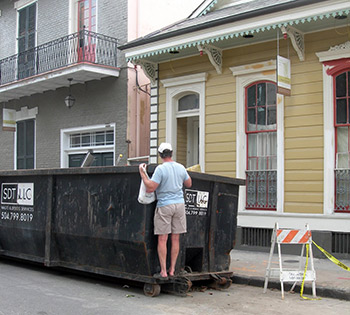
Photos here and on the cover by Stephanie Cavanaugh.
SOMETIMES, AND BY THIS I mean almost daily, the design pages of the New York Times provoke me to scream, Are you out of your minds!?
And I say this fondly, being an ex-New Yorker, born and raised and schooled and—to demonstrate my street cred—once able to tell at a glance a real Gucci bit on a shoe from a knock-off, and consider this essential information.
I am looking at a planter by designer Huy Bui, who wears what might impolitely be called a shit-eating grin in the photo that accompanies the interview, as well he should. It’s really a terrarium and it’s constructed of oak strips that you mount yourself, “like Lego blocks,” he says, on a charred wood base, whatever that is. Part of his “Homemade Collection,” it can sit on your tabletop for $850.
I think, I’m in fact sure, the parts for something like this are lurking in our garage, or possibly the basement. Maybe the attic.
For your outdoor space, Mr. Bui suggests various planters, including one with “deep asymmetrical ripples,” called the Babylon. Designed by Harry and Camila for Dedon, “it comes in four sizes, the largest more than three feet tall—ideal for a tree.” It costs $1,385 and is made of polyethylene.
Nestling near our pond, in a collection of ferns, is a gorgeous terracotta number with deep asymmetrical ripples. It’s more than three feet tall, ideal for a tree. The Prince brought it home from who knows what sidewalk last year—it’s now growing a fine furze of moss, which is a lovely touch, and also very en trende, according to Bui.
(Furze, I am informed by the editor is a kind of gorse, a rather thorny plant, and not a spread of soft fuzz, which is what it sounds like. Doesn’t it? Well, that is what editors are for.)
Furz, upon further investigation, also means fart in German—ein furz. And did you know that trump is British slang for fart? That is neither here nor there, but wonderful, I think.

The Prince, “shopping” for treasure in New Orleans. / Photo by Stephanie Cavanaugh.
Now, no one loves pots and planters more than I do—see various posts on the subject—but the most I’ve ever paid for one, and technically it’s not a planter but an Art Deco umbrella stand cunningly redeployed as a fern holder, was a hundred bucks. I considered this a charitable contribution, though alas not a tax write-off, to the legal costs of a couple of guys who got caught selling a minuscule amount of weed, which is also neither here nor there.
Otherly, the plants that ornament our porches and gardens (my, that sounds a lot grander than it is) were found discarded on the sidewalks, or sticking out of dumpsters, or they were gifts of a sort, as in: Please take this or I’m throwing it out.
Generally, all one needs to do to land free stuff is have knowledge of the trash truck timetable for various neighborhoods; of course, the finer the neighborhood the finer the trash.
Where once Capitol Hill was considered more shabby than chic, and one needed to rummage in Georgetown or Cleveland Park—and we’ve many fine finds from foraging out west—my neighborhood streets are now littered with Bugaboo strollers pushed along by au pairs and nannies endlessly chattering on their cell phones in French, and Spanish, and Chinese, and the restaurant line for Rose’s Luxury stretches hours down the sidewalk.
Add to that being a rather transient place, what with upheavals of political fame and fortune, and the Hill’s pickings are excellent—you can furnish a house, rather nicely, from the sidewalks.
I’ve found pots and urns and pedestal bases made of stone and concrete, porcelain and ceramic. The cast-iron pot I discussed several columns ago was a moving giveaway. Weighing easily 100 pounds and valued at around $350 (triple that, probably, in New York) I was very moved, as was my back. It holds a sago palm and summers on the front porch atop another find, this one picked up at curbside, a wonderful stone stand with protruding lion heads that winters in the living room and makes a fine extra seat when magazines aren’t piled on it. I don’t recall which yard sale or alleyway disgorged the Chinese pot on the back porch, with its green leaves dancing with brightly painted butterflies. I am, in fact, amazed that it is not broken.
Who throws this stuff out? But they do.
While New York is in a class of its own for foolish pricing of fantastic junk, Washington also has its moments.
On a recent meander through the chichi antiques shops of upper Georgetown I encountered a broken plaster pedestal bearing a fancy parchment tag with $350 handwritten in a scrolling script the color of faded blood.
As it happens, we have a similar broken pedestal, two in fact. Purchased at my favorite Virginia junk shop, Slindy’s of Culpeper (I added that “of Culpeper” to give the place some class), it was not broken when I discovered it, shoved into a dusty shop corner. And it was shoved into that corner because it is not the sort of thing that attracts the typical Slindy’s client, who leans toward Russian military memorabilia and clown paintings on black velvet.
Therefore, I snapped it up for 10 bucks, figuring it would be a fine perch for my jasmine come winter in my tiny solarium. As such things happen, I carried it out to The Prince’s pick-up truck, which is always handy for such expeditions, and set it down gently on the pavement where it instantly and tragically cracked in half.
After eying the two segments for some time, I had a eureka moment: shove a plastic water bottle with the top cut off into the pedestal’s neck and make a vase. This is a clever trick, I might add.
Being a good and generous mother, I gave the other half of this pedestal (valued at $350) to Baby, who has stuffed it with curly willow branches and set it in a corner of her living room in Raleigh, home of fried Twinkies.
Speaking of brilliant tricks (there will eventually be mention of a garden): That same day in that same shop in Georgetown, I saw a table set with lovely faded purple damask napkins. Eight for $100.
While I find damask a little fusty in its white form, this color version was delicious. As it happened, I have a drawer full of white damask napkins that I couldn’t bring myself to toss out as they were inherited from my mother.
So I bought a large bottle of purple Rit dye and for a grand total of $4.98 and I now have eight beautiful napkins—that grow prettier as they fade in the wash.
Napkin trick: I grew up with and have always used cloth napkins. In cotton or linen they’re so much more pleasant than paper, and not in the least difficult to care for if you handle them the way my mother did: Toss them in the washing machine, fold them in half and pull and pat them flat, then hang them over a rail or a chair back to dry.
If you do this right, they’ll have just enough rumple that you look, not a slob, but a casually elegant housekeeper. Like someone with a garden in Provence, without the garden. Brilliant, no?
—Stephanie Cavanaugh
Gardener Cavanaugh is writing a book on city gardening. You can read all installments of her MyLittleBird column by typing “Green Acre” in the Search box at the top right of the screen.

We love it! One man’s trash is another man’s treasure. That is why we recycle all the items that we possibly can at http://www.litrashremoval.com, because who knows what can be found. We especially love the Prince shopping for goods!!
The Prince shopping for treasures! What a treat! Of course this, too, is neither here nor there…
What a lovely idea to dye the white napkins…. I have a whole bunch that I never use
and I love them because of the size–they are extra large and soft to the touch…
Thanks so much for the great tip!! As for the photo of the Prince…CHARMING!!!!
Love this as always! Finally, we get to see the Prince and from such an alluring perspective! What a lovely derriere and set of gams!